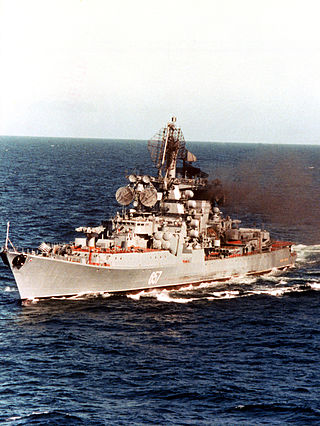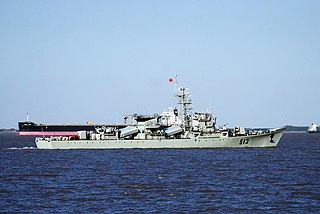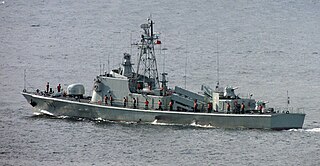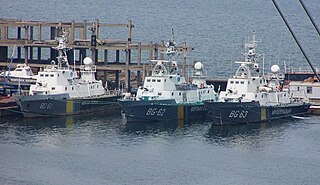
The Admiral Petre Bărbuneanu-class corvette is a series of four corvettes designed and constructed for the Romanian Naval Forces primarily for anti-submarine warfare. Only two corvettes out of a total of the four are still in service. Designed and constructed in the 1980s, they are a product of the Cold War with their armament and sensors based on Soviet designs. This class of corvettes was superseded by the Rear-Admiral Eustațiu Sebastian (Tetal-II) class.

The Kresta II class, Soviet designation Project 1134A Berkut A, was a class of guided missile cruiser built by the Soviet Union for the Soviet Navy. The NATO lists the class as "cruisers" mainly due to the Metel anti-ship missile system capable to strike not only submarines but also surface vessels. They were succeeded by the larger Kara class cruisers.

The Type 053 is a family of Chinese frigates that served with the People's Liberation Army Navy Surface Force, and a small number of foreign navies.

The People's Liberation Army Navy Surface Force is the surface warfare branch of China's People's Liberation Army Navy (PLAN), consisting of all surface vessels in operational service with the PLAN. The PLAN Surface Force operates 661 ships organized into three fleets: the North Sea Fleet, the East Sea Fleet and the South Sea Fleet.
The People's Liberation Army Navy (PLAN) is the naval branch of the People's Liberation Army (PLA), the armed forces of the People's Republic of China. The PLAN force consists of approximately 250,000 men and over a hundred major combat vessels, organized into three fleets: the North Sea Fleet, the East Sea Fleet, and the South Sea Fleet.

The Type 037 corvette is a series 400–500 ton corvette type classes in service with the People's Liberation Army Navy. Unlike western navies, the People's Liberation Army Navy does not have dedicated patrol boats in its inventory. Instead, a large variety of corvette type classes, in the form of missile boats and submarine chasers fulfill the tasks of patrolling China's territorial waters. The Egyptian Navy operates eight vessels.

The Myanmar Navy is the naval warfare branch of the Tatmadaw, the armed forces of Myanmar. With 19,000 active personnel on duty, the navy operates more than 227 vessels. Prior to 1988, the navy was small, and its role in counter-insurgency operations was smaller than those of the army and the air force. The navy has since been expanded to take on a more active role in defense of Myanmar's territorial waters.

The Stenka class is the NATO reporting name for a class of patrol boats built for the Soviet Navy, KGB Border Troops and Soviet Allies. The Soviet designation was Project 205P Tarantul. The boats are an anti-submarine patrol version of the Osa-class missile boat.
Siping (519) was a Type 053H frigate of the People's Liberation Army Navy. On 28 July 2010, she was renamed to Lushun.
BNS Nirbhoy was a Type 037-class submarine chaser of Bangladesh Navy. She served the Bangladesh Navy till 2022.
BNS Durjoy was a Type 037-class submarine chaser of the Bangladesh Navy. She served the Bangladesh Navy from 1982 to 1995.

Marshal Timoshenko was a Project 1134A Berkut A class cruiser of the Soviet Navy. The eighth ship of her class, the vessel served during the Cold War with the Northern Fleet, often operating in the Atlantic Ocean but also travelling to various ports in the Mediterranean and Red Seas. The cruiser was taken out of service to be modernised in 1988 but a lack of funds meant the work was not completed. Instead Marshal Timoshenko was decommissioned in 1992.
The Yan Nyein Aung-class submarine chaser, also known as 63m stealth submarine chaser, is the first indigenous stealth submarine chaser class of the Myanmar Navy. The lead ship of the class is UMS Yan Nyein Aung (443) and she was commissioned with UMS Yan Ye Aung (446) on 24 December 2020. This class is intended to replace the ten old Hainan-class submarine chasers.
Anshun (554) was a Type 053 frigate of the People's Liberation Army Navy. She was sold to the Myanmar Navy and renamed Maha Bandula.

Huaiyin (513) was a Type 053H frigate of the People's Liberation Army Navy. She was renamed Huai'an in 2006.
Changsha (516) was a Type 053H frigate of the People's Liberation Army Navy (PLAN). The ship, renamed Jiujiang in 1981, was constructed in 1975 in the shipyards of Hudong in Shanghai. Per early reports, the ship was retired in 2017, but the official documentation shows the retirement year as 2018. The ship was the oldest serving frigate at its retirement. After its renaming, it took on a vital role as the PLA's only combat support vessel of its kind and sent minor shock waves through the military when it was decommissioned.
Nanping (517) was a Type 053H frigate of the People's Liberation Army Navy.
Changzhi (519) was a Type 053H frigate of the People's Liberation Army Navy.
Ji'an (518) was a Type 053H frigate of the People's Liberation Army Navy.

Razyashchiy was a Project 1135 Burevestnik-class Large Anti-Submarine Ship or Krivak-class frigate of the Soviet Navy. Displacing 3,200 tonnes full load, the vessel was built around the Metel anti-submarine missile system. Launched on 22 July 1974, Razyashchiy joined the Pacific Fleet of the Soviet Navy. While serving in the Arabian Sea, in 1983, Razyashchiy suffered minor hull damage from colliding with the destroyer USS Fife while approaching a US fleet. The ship also undertook visits to Port Louis, Mauritius, and Danang, Vietnam, to, among other objectives, enhance the relationships between these countries and the Soviet Union. In 1991, the vessel was transferred to the newly-formed Russian Navy. After nearly twenty years of service, however, Razyashchiy was in a poor state and so was decommissioned on 29 October 1992 and sold to be broken up on 6 October 1994.








